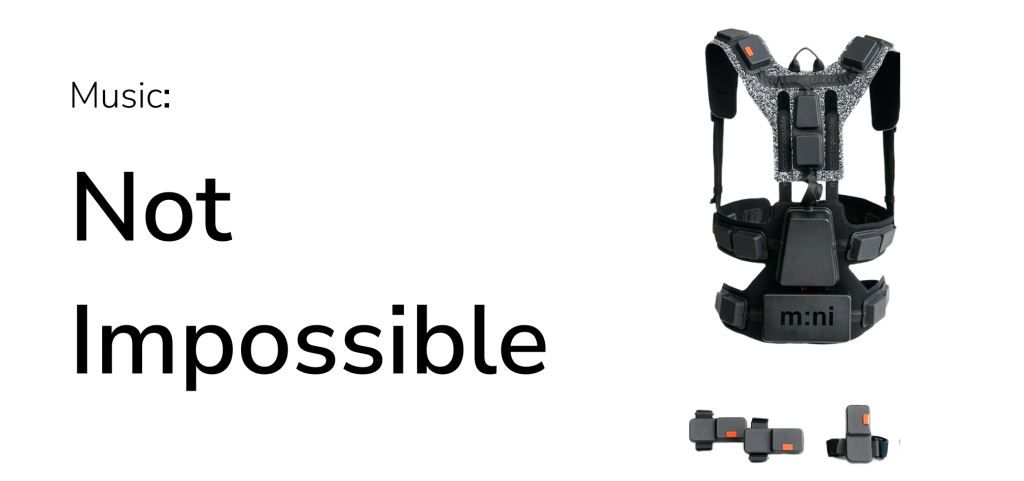
The Not Impossible haptic suit consists of two ankle bands, two wrist bands, and a backpack that fastens with double straps over the rib cage, allowing anyone to utilize it. These suits allow the Deaf population to enjoy the enchantment of music in a fresh and fascinating way by translating music into tactile sensations.
Music’s expressive power has left an indelible impression on human society, a phenomenon frequently thought to be universally relatable. That universality has frequently neglected the diverse experience realities of Deaf and Hard-of-Hearing people. Their musical relationship oscillates between medical and societal theories of impairment. While hearing loss is fundamentally a physiological disability, the social consequences are significant when considering communal delight and shared emotional experiences. Music is more than just a succession of aural sensations; it is a shared emotional tapestry, a communal banquet of delights, joys, and sorrows. The medical concept of disability may explain the inability to sense sound traditionally. Still, it falls far short of addressing the social disadvantages of exclusion from the shared cultural delight as enriched as music.
The functional solutions paradigm, which embraces this duality, pivots from antiquated notions of incapacity, presenting a new, comprehensive vision. It turns the emphasis away from medical interpretations and toward a broader canvas, highlighting the diversity of experiences and the possibility of inclusion. The Mission Impossible haptic suit’s unique technology exemplifies this model, transforming auditory experiences into haptic revelations. Individual musical notes are converted into unique vibrations by the suit.[1] The suit pulses synchronously with the melodies, providing Deaf and Hard-of-Hearing users a tangible dance of rhythms and beats, crafting an immersive soundscape through the skin, heart, and soul.
“When the song was getting lower, not only did the different parts of you vibrate; it actually got softer and more in-depth. And when it was louder, my whole body was shaking. Just the level of precision they put into it was astounding.”
Amanda Landers, “Haptic Suits Help Deaf People Experience Music.”
The haptic suit embodies the functional solutions model’s belief that innovation and creativity can lead to breakthrough solutions that make a real difference in the lives of Deaf people by fully participating in the musical world around them.
These haptic suits are an example of modern engineering, built on cutting-edge technology ranging from microprocessors, which serve as the suit’s beating heart, to wireless capabilities, strong batteries, and artificial intelligence.[2] Yet, issues of pricing and availability hamper their widespread adoption. While financial constraints still limit individual ownership, the company offers a package strategy for organizations. These packages start at a few thousand dollars to a six-figure price tag and include the haptic suits with a D.J. expertly trained to adapt the vibrations to certain musical pieces.[3] These service suites also feature extensive on-site support, achieving the dual goals of making haptic suits accessible to the Deaf and Hard-of-Hearing communities while assuring a consistent user experience. While financial constraints currently limit individual ownership, this packaging model represents a step toward a more globally inclusive future, where entrance cost no longer muffles experience vibrancy.
Looking ahead, the transformative potential of the Music: Not Impossible haptic suit within the Deaf and Hard-of-Hearing community appears boundless. Imagine educational settings where Deaf students not only read about historical events but also feel the pulsations of historical music, giving them a more immersive learning experience. Or consider therapy sessions where vibrations offer a novel form of sensory relaxation, aiding in stress relief and emotional well-being. Additionally, cultural events, like Deaf theater and dances, could incorporate these suits, adding sensory engagement and expression layers. However, the promise of these suits extends beyond the Deaf community. They can become a tool of universal sensory augmentation. In concerts, attendees, irrespective of their hearing abilities, can opt for a multi-sensory experience, melding the traditional auditory delight with haptic wonders.
References
[1] “Music: Not Impossible,” Not Impossible Labs, https://www.notimpossible.com/projects/music-not-impossible.
[2] Sarah Bahr, “Haptic Suits Help Deaf People Experience Music,” The New York Times, August 20, 2023, https://www.nytimes.com/2023/08/20/style/haptic-suits-deaf-music.html?searchResultPosition=1.
[3] Jennifer Vanasco, “Vibrating Haptic Suits Give Deaf People a New Way to Feel Live Music.” NPR. July 17, 2023. https://www.npr.org/2023/07/17/1186173942/vibrating-haptic-suits-give-deaf-people-a-new-way-to-feel-live-music.